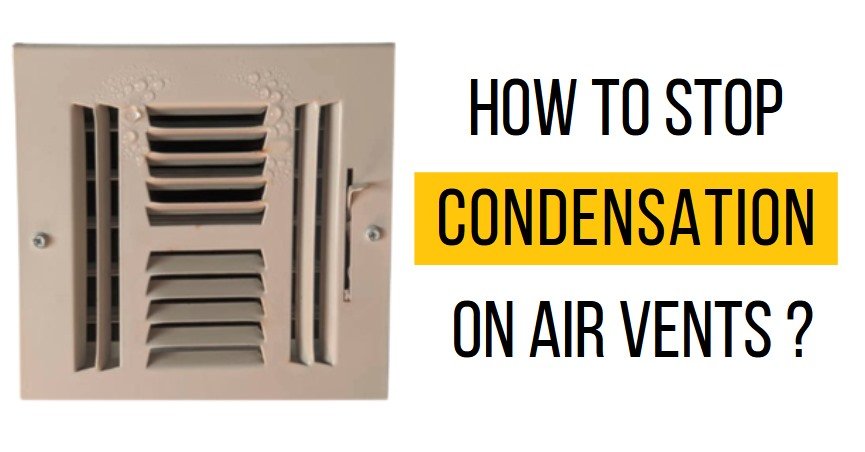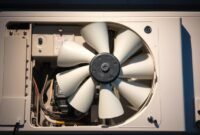Are you tired of water droplets on your air vents? Condensation on air ducts is a common problem. It can lead to mold and make your HVAC less efficient.
Moisture forms when warm air meets cold surfaces. I’ll show you why this happens and how to stop it. This will keep your home comfy and your HVAC working well.
Let’s tackle this issue together. We’ll protect your home’s air quality and infrastructure.

Understanding the Science Behind Air Vent Condensation
Condensation on metal ducts is a common issue many homeowners face. I’ll explain why water droplets form on your air vents. I’ll also cover what factors lead to this problem.
Read also: What Causes Condensation on AC Vents?
What Causes Condensation on Air Ducts
The main reason for condensation is the big temperature difference. Your cool air conditioning system meets the warm air outside. This creates a perfect spot for moisture to gather.
- Cold surfaces attract water vapor from warm air
- Dirty air filters can make condensation worse
- Not enough insulation also leads to more moisture
The Role of Temperature Differences
Think of your air ducts like a cold drink on a hot day. When warm, humid air hits the chilled metal ducts, water droplets form right away. It’s like how water beads up on a glass of iced tea.
| Temperature Condition | Condensation Likelihood |
|---|---|
| High Indoor Humidity | Very High Risk |
| Poor Duct Insulation | High Risk |
| Significant Temperature Variation | Extreme Risk |
Impact of Humidity Levels
Humidity is key in preventing water damage near your air vents. Higher humidity means more chance of condensation. This can lead to mold and problems with your HVAC system.
- Ideal indoor humidity: 30-50%
- Humidity over 60% raises condensation risk
- Use dehumidifiers to keep moisture levels down
Knowing these science basics helps you spot and stop condensation problems early. This way, you avoid bigger issues with your home’s cooling system.
Common Signs of Problematic Duct Condensation
Spotting condensation issues in air conditioning ducts early can save you money and health risks. Your HVAC system often gives clear warnings when moisture is a problem.
Here are the key signs that your air conditioning ducts might have moisture problems:
- Visible water droplets forming on air vents
- Unexpected water stains on nearby walls or ceilings
- Musty or damp odors circulating through your home
- Unexplained dampness around insulating material near ducts
Leaking ducts can lead to more issues. Watch for these signs closely, as they often mean moisture problems that need quick action.
| Condensation Sign | Potential Severity | Recommended Action |
|---|---|---|
| Water Droplets on Vents | Moderate | Check humidity levels, inspect insulation |
| Wall/Ceiling Water Stains | High | Immediate professional assessment needed |
| Musty Odors | Critical | Investigate possible mold growth |
Acting fast on these signs can stop bigger damage to your HVAC system and keep your home’s air clean.
Health Risks Associated with Sweating Air Ducts
When air conditioner ducts sweat, it’s not just a moisture issue. These wet areas become breeding grounds for health hazards. These can quietly affect your home’s air and your family’s health.
Ducts sweating might seem like a small problem, but it can have big consequences. The moisture creates ideal conditions for harmful microorganisms to grow.
Mold and Mildew Growth
It’s important to prevent moisture in AC vents to avoid mold and mildew. These can quickly grow in damp ducts. They spread harmful spores all over your home.
- Mold can grow within 24-48 hours of moisture exposure
- Spores spread rapidly through air circulation systems
- Invisible to the naked eye until significant growth occurs
Indoor Air Quality Concerns
Too much moisture in air conditioner ducts affects the air you breathe. This contaminated air can lead to many health problems.
| Air Quality Impact | Potential Risks |
|---|---|
| Microbial Contamination | Increased allergen levels |
| Humidity Imbalance | Respiratory system stress |
| Spore Circulation | Potential lung irritation |
Respiratory Issues and Allergies
Being exposed to moist, contaminated air can cause respiratory problems. People with asthma or allergies are more at risk.
- Increased likelihood of allergic reactions
- Potential asthma trigger
- Compromised respiratory system function
Fixing sweating air ducts is more than just home upkeep. It’s about keeping your health safe. By controlling moisture and keeping air clean, you can lower these risks.
How to Stop Condensation on Air Vents

Dealing with sweating air ducts can be frustrating. But, I have some practical solutions to help you get rid of water droplets from air conditioning systems. Let’s explore effective ways to keep your HVAC system dry and working well.
To fix sweating air ducts, we need a multi-step approach. I’ll share the most effective methods to solve condensation problems:
- Reduce indoor humidity levels
- Improve air duct insulation
- Seal any air leaks
- Optimize HVAC system settings
Controlling humidity is key to stopping water droplets on your air vents. Using a dehumidifier helps keep moisture levels down. Also, insulating air ducts well stops temperature differences that cause condensation.
| Condensation Prevention Method | Effectiveness Rating |
|---|---|
| Dehumidifier Usage | 90% |
| Duct Insulation | 85% |
| Air Leak Sealing | 75% |
| HVAC System Maintenance | 80% |
Sealing air leaks in your ductwork is another important step. Small gaps can cause temperature differences that lead to condensation. It’s wise to have a professional check your ductwork to find and seal leaks.
Remember, regular maintenance is your best defense against air vent condensation. By using these solutions, you’ll protect your HVAC system and improve your home’s air quality.
Essential Maintenance Tips for HVAC Systems
Keeping your HVAC system in top shape is key to preventing air vent sweating and reducing humidity. Regular maintenance stops hvac vent sweating early. A well-maintained system is your best defense against water buildup.
Your home’s climate control system needs regular care to work its best. Maintenance is like a health checkup for your HVAC. It catches issues early and keeps everything running smoothly.
Filter Replacement Strategy
Filters are the lungs of your HVAC system. I suggest a strict replacement schedule:
- Standard filters: Replace every 60-90 days
- Homes with pets: Replace every 45 days
- Homes with allergy sufferers: Consider monthly replacements
Cleaning and Inspection Routines
Regular cleaning cuts down humidity on air registers and prevents water buildup. Here’s a maintenance checklist I follow:
- Clean air ducts every 3-5 years
- Inspect ductwork for moisture issues
- Check insulation around air vents
- Remove dust and debris from air registers
Professional Maintenance Requirements
While DIY maintenance is key, professional HVAC technicians offer deep cleaning and system checks. I get professional inspections twice a year – in spring and fall. This ensures my system is ready for temperature extremes.
By following these maintenance tips, you’ll greatly reduce hvac vent sweating risk. You’ll also keep your home climate system healthy and efficient.
Proper Insulation Techniques for Air Ducts
Keeping your metal ducts dry is key to a healthy home. The right insulation stops moisture and protects your HVAC system.
For fighting condensation on air ducts, the right insulating material is essential. I suggest a multi-layer approach. It acts as a strong barrier against temperature and humidity changes.
- Choose high-quality foam insulation with a foil outer layer
- Ensure complete coverage of metal ducts
- Focus on areas with significant temperature variations
- Seal all insulation edges and seams thoroughly
Understanding your home’s climate and HVAC system is vital. Always start with a detailed inspection of your ductwork. This helps spot problem areas.
Different insulation materials suit different environments. Fiberglass, foam, and reflective insulation each have their own benefits. The aim is to create a thermal barrier that stops moisture from forming on metal ducts.
Pro tip: Don’t cut corners on insulation quality. Spending on top-notch insulating material can save you money on energy and prevent HVAC damage over time.
Managing Indoor Humidity Levels
Keeping indoor humidity in check is key to avoiding moisture on AC vents. It also helps keep your home comfortable. Too much moisture can cause condensation and harm your HVAC system.
Using Dehumidifiers Effectively
Dehumidifiers are great for lowering humidity and stopping moisture on air registers. Place them in humid areas like basements, bathrooms, and kitchens.
- Choose a dehumidifier that fits your space size
- Regularly clean the unit’s filter to keep it working well
- Set the humidity level between 30-50% for the best comfort
Natural Ventilation Methods
Warm air moving around can naturally lower humidity. Here are some ways to boost air circulation and stop moisture buildup:
- Open windows when it’s less humid outside
- Use ceiling fans to move air around
- Open windows on opposite sides of your home for cross-ventilation
Using these methods can help manage indoor humidity. This prevents moisture on AC vents and makes your home more comfortable. Remember, keeping an eye on humidity and acting fast is important for good indoor air quality.
Identifying and Fixing Leaky Ducts
Leaking ducts can quietly cause trouble in your home’s air conditioning. Finding these issues early can save you a lot of money. It also helps avoid comfort problems.
Watch for these key signs of leaking ducts:
- Unexplained increase in energy bills
- Inconsistent room temperatures
- Excessive dust around air vents
- Unusual whistling or hissing sounds from ductwork
- Visible gaps or cracks in duct connections
When I inspect ducts sweating or possible leaks, I follow a detailed plan. First, check exposed ductwork in attics, basements, or crawl spaces. Look for tears, loose joints, or damaged insulation.
For small leaks, you can use HVAC tape or duct sealant. These fixes can handle minor issues. But for bigger repairs, a professional HVAC technician is best. They can do a detailed check and fix it right.
Professional duct sealing includes:
- Comprehensive leak detection
- Precise measurement of air leakage
- Comprehensive sealing with professional materials
- Insulation restoration
Fixing leaking ducts quickly boosts your home’s energy efficiency and air quality. It also makes your home more comfortable. Don’t let small leaks turn into big problems.
Read also: Why is My Portable AC Producing so Much Water?
The Importance of Proper HVAC Settings
Managing your HVAC system settings is key to stopping condensation on air vents. I’ve found that precise temperature and fan control can greatly reduce moisture in air conditioner ducts.
Temperature is a big factor in stopping condensation on air vents. Setting your system a bit cooler can lower humidity and reduce HVAC vent sweating. The goal is to find a balance that stops excess moisture without cooling your space too much.
- Set thermostat 2-3 degrees lower than usual
- Adjust fan speed to improve air circulation
- Maintain consistent temperature settings
Fan speed is also important in fighting air vent condensation. Increasing airflow helps spread moisture better. I suggest trying different fan settings to find the best for your home.
Think about using your HVAC system’s auto mode. It can better control temperature and humidity. This setting lets the system adjust itself, which can prevent condensation on your air ducts.
Every home is unique. What works for one might not work for another. Keep an eye on your air conditioner ducts and be ready to make small changes to stop HVAC vent sweating effectively.
When to Call a Professional HVAC Technician

As a homeowner, I’ve learned some car vent condensation solutions need a pro. DIY fixes can help, but there are times when an HVAC technician is your best friend. They can fix sweating air ducts.
Knowing when to call a pro can save you money and prevent damage to your air conditioning. Here are signs you need an expert:
- Persistent water droplets that won’t disappear
- Unusual musty odors near air vents
- Visible mold growth around ductwork
- Significant temperature inconsistencies in your home
- Unexplained increases in energy bills
Professional HVAC technicians have the skills to fix air conditioning systems. They can find problems that you might miss. They use advanced tools and have years of experience.
I suggest getting professional maintenance twice a year. These checks can stop condensation problems before they start. A skilled technician can fix issues like duct insulation and humidity control.
Investing in professional maintenance is cheaper than fixing water damage or replacing your system. Your home’s comfort and air quality depend on it.
Conclusion
I’ve shown you how to stop condensation on air vents. Now, it’s time to use this knowledge. Knowing why water builds up on air vents is key to avoiding damage and health risks.
Dealing with condensation is more than just a simple task. It’s about keeping your home safe and healthy. By following the tips we’ve shared, like controlling humidity and keeping your HVAC in check, you can cut down on water on your air vents.
Prevention is always better than fixing problems later. Simple steps like checking your system, using dehumidifiers, and fixing leaks can save you money. Your home’s air and structure depend on these steps.
Don’t worry if it seems like a lot. Start with easy steps and learn more as you go. If you can’t get rid of condensation, a pro HVAC tech can help. They’ll give you advice that fits your home’s needs.


